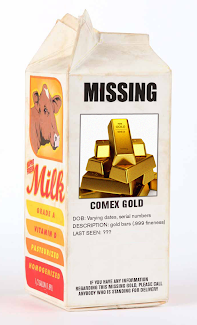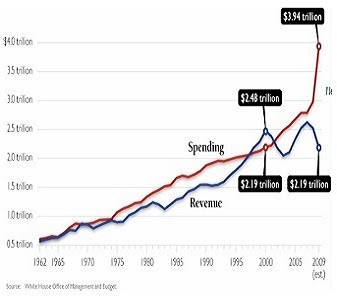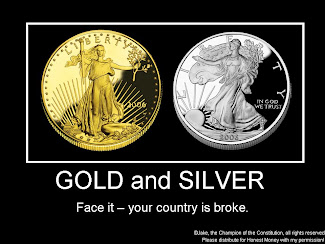The price of gold and silver will both hit new highs in 2014. The price of gold goes north of $2,000, and silver will quickly go over $50. When it does, it will get a little crazy. – Eric Sprott, Sprott Investment Management - SilverDoctors.comA reader the other day was inquiring about the gold/silver ratio (GSR). The GSR is an interesting metric that converts the price of gold and silver into the number of ounces of silver it would take to buy one ounce of gold. Over the entire course of history, that I know of, the GSR has been as low as 8, which was the fixed ratio used by the Roman Empire for exchanging gold and silver.
Interestingly – at least to me – if you look at the GSR over the last 350 years, it held steady at around 15 until the middle/late 1800′s. At that point in time it rose steadily as the gold standard was slowly eroded by United States. President Lincoln was actually the first President to disconnect gold and silver as the Constitutionally mandated currency when he allowed someone to use Government-issued bonds to settle a debt obligation (the action was later upheld by the Supreme Court under President Grant).
At any rate, to cut to the chase, since the Federal Reserve was founded, the GSR has ranged from 15 to 100. The low-end of the range usually correlates with bull market tops in gold/silver and vice versa with the high-end.
Currently the GSR is 60 and I believe the recent movement in the GSR is signalling the possibility of a big move ahead for gold and an even bigger move for silver. I have compiled my analysis in this article published by Seeking Alpha today: The Gold/Silver Ratio: Forecasting A Big Move Higher For Silver
I don’t know if the next big move higher that I believe is coming will be the final stage of the precious metals bull market, but I do think that based on the extraordinary supply/demand fundamentals for gold that the next move will be big for gold and spectacular for silver.





![[Most Recent Quotes from www.kitco.com]](http://www.kitconet.com/images/sp_en_6.gif)








Hot topic : How does supply and demand , energy costs to mine future ore , lead time to re-up the mines inventory all play into what's a certain period for the "final high price" once the price of silver arrives at $ 50 ? History has proven that the Central banks will try and control the physical but will this time prove different ?
ReplyDeleteWhat about bronze? Just looking out for our hockey guys in Sochi since they won't have any gold or silver to worry about.
ReplyDeleteI believe the gold/silver ratio is irrelevant at this point in monetary history. When the current system is reset I believe a G/S ratio could be 1000/1. Silver is too important as an industrial commodity to be hoarded as money. I’m am not saying fiat can’t be made in silver, but when the dust settles from this current monetary crisis I believe silver holders will be sorely disappointed. We don’t need a bimetallic system and I believe that only gold will be used to recapitalize the system. Just my very humble opinion.
ReplyDeleteI think the main part of the equation you are missing is Silver supply. Silver is mostly used up and not reclaimed in industrial applications. The result will be a scarcity of Silver and once this is realized there will be a panic to own physical Silver, at any price.
DeleteTwo more major factors are rising energy prices and fewer large scale mining operations going online. This could propel Silver to par with Gold.
Just my very humble opinion.
Joe, I don't believe there is a silver shortage at all, I don't believe there is a shortage of gold either. The same can be said of oil, copper, or any other metal. I believe that there are a lot of people and entities who hold silver and expect it to perform as money again. When silver doesn't fulfill that role it will be unloaded en mass and the price at whatever level it falls from will be significant. Silver will have a true supply demand price as a commodity not as money like many expect. I don't see us flipping silver coins for groceries again. I believe gold will be used to recapitalize the system and settle trade between central banks. Gold will act as a reserve to central banks instead of US T-bonds and will determine the value of global currencies. Why hasn't the SLV supply gone down like the GLD? SLV has supply has gone up! The question I feel that is most relevant is what is the most likely direction the current system is headed?.The system we have now has already failed. Just my humble opinion
DeleteAnon to Joe, you might be right in your humble opinion as Joe is also. What solid evidence are you basing your theory on other then your own words ? How about this fact...when the Hunt brothers were hoarding silver and shipping it over to Switzerland back in the 70's officials stated that they almost pulled off total control of physical silver had it not been for Alan Greenspan starting computerized derivative trading of commodities and Volker ramping up interest rates. Silver en mass ? Paper maybe. It seems that ever since Wallstreet and central banks got in on the act of creating phony paper silver , confusion over how much physical that there is will run rampant .
DeleteHere's one more from the experts - if gold were to vanish from the face of the earth civilization would go on as though nothing happened . If it were silver instead , civilization would cease to exist. I would say that that has real value attached to it , IMHO.
There is no way the Gold to Silver ratio can drop to 1:1000 as one reader suggested because at that rate anyone would gladly trade one Gold ounce for two monster boxes of silver. Silver will be long gone way before the ratio gets even more out of whack than it is today.
DeleteI'll go with silver outdoing gold. even if the GSR only drops to 1/40 silver comes out ahead on a % basis. as to new highs I think it takes into late 2015. if your in the game for the long term that's not that far off.
ReplyDeleteFull Show: The Deep State Hiding in Plain Sight February 21, 2014
ReplyDeleteMike Lofgren, a former GOP congressional staff member with the powerful House and Senate Budget Committees, joins Bill to talk about what he calls the Deep State, a hybrid of corporate America and the national security state, which is “out of control” and “unconstrained.” In it, Lofgren says, elected and unelected figures collude to protect and serve powerful vested interests. “It is … the red thread that runs through the history of the last three decades. It is how we had deregulation, financialization of the economy, the Wall Street bust, the erosion or our civil liberties and perpetual war,” Lofgren tells Bill.
Lofgren says the Deep State’s heart lies in Washington, DC, but its tentacles reach out to Wall Street, which Lofgren describes as “the ultimate backstop to the whole operation,” Silicon Valley and over 400,000 contractors, private citizens who have top-secret security clearances. Like any other bureaucracy, it’s groupthink that drives the Deep State.
http://billmoyers.com/episode/the-deep-state-hiding-in-plain-sight/
found out why the Swiss franc peg to the Euro hasn't blown up yet, despite on since Sept 2011:
ReplyDeleteapparently they have not yet turned on the money gusher in Brussels or Frankfort.
so I guess that puny nation is now lulled into thinking it can keep it there forever, "buying up" endless euros with fiat francs, driving the euro up & their franc down to maintain the peg (since being swiss all they can print is franc fiat)
http://www.safehaven.com/article/32868/what-will-blow-up-first-part-i
It is clear that Europe is headed for yet another recession unless the ECB adopts its version of Quantitative Easing - FAST! The Bundesbank's surprising capitulation on ECB sterilization is indicative of the seriousness of the accelerating problem.
Silver is seeing increasing uses everywhere. Nano products (anti - microbial) such as work socks,
ReplyDeletedeodorant, linoleum, water filters etc. Big uses in solar panels and all those little gadgets that most people worship - also welding, solder supplies and batteries. Remember - palladium saw increased
industrial use....does catalytic converter ring a bell. Check out those historic palladium price
charts...I hear a SILVER BELL RINGING.
....I HEAR A LOUD SILVER
Fed knew about Libor rigging in 2008
ReplyDeleteSenior Fed official first flagged Libor issue at a policy meeting in April 2008, newly released documents reveal
The US Federal Reserve knew about Libor rigging three years before the financial scandal exploded but did not take any firm action, documents have revealed.
According to newly published transcripts of the central bank’s meetings in the run-up to and immediate aftermath of the collapse of Lehman Brothers, a senior Fed official first flagged the issue at a policy meeting in April 2008.
William Dudley expressed fears that banks were being dishonest in the way they were calculating the London interbank offered rate – a global benchmark interest rate used as the basis for trillions of pounds of loans and financial contracts.
“There is considerable evidence that the official Libor fixing understates the rates paid by many banks for funding,” he said.
The transcript of the Fed’s April 2008 meeting raises questions about why the central bank did not move to properly tackle the scandal. There was no official regulator for Libor at the time, and officials at the US Federal Reserve tried to blame British authorities for allowing the benchmark interest rate to get out of control in the first place.
http://www.telegraph.co.uk/finance/libor-scandal/10654977/Fed-knew-about-Libor-rigging-in-2008.html
DEEP STATE OF CORRUPTION
Danielle Park talks with "In Bed With Wall Street" author Larry Doyle
DeletePublished on Feb 21, 2014
Danielle Park, President of Venable Park Investment Counsel Inc. www.venablepark.com and the financial blog www.jugglingdynamite.com in conversation with former Wall Street trader Larry Doyle, about his important new book, "In Bed With Wall Street. The Conspiracy Crippling Our Global Economy."
http://youtu.be/DtSxquDeY0o
If you check the U. S. Regulatory Agencies ( IRS , CFTC , SEC , etc. ) they are the same " Tribe " members as the World Bank , IMF , FED , Banks too Big to Jail , the MSM , Hollywood , and owners of the D.C .Politicians !
DeleteThe Shadow Lobbying Complex: How Corporations Are Hiding Vast Influence Peddling Efforts
ReplyDeleteA new exposé in The Nation magazine reveals that much of the lobbying money spent on shaping policy in Washington is going unreported. For the third straight year, the official amount spent by lobbyists has declined, and the number of registered lobbyists is the lowest it’s been in more than a decade. But these numbers are misleading, says reporter Lee Fang, author of the "The Shadow Lobbying Complex: On paper, influence peddling has declined. In reality, it has gone underground."
AMY GOODMAN: But a new cover story in The Nation magazine reveals how these numbers are misleading. It’s headlined "The Shadow Lobbying Complex: On Paper, Influence Peddling Has Declined. In Reality, It Has Gone Underground."
http://www.democracynow.org/2014/2/21/the_shadow_lobbying_complex_how_corporations
The "There Is No Inflation" Report: Monthly House Payments for Home Buyers Increased 21% From a Year Ago
ReplyDeleteRealtyTrac today released a housing affordability analysis showing that the estimated monthly house payment for a median-priced three-bedroom home purchased in the fourth quarter of 2013 — including mortgage, insurance, taxes, maintenance, and subtracting the estimated income tax benefit — increased an average of 21 percent from a year ago in the 325 U.S. counties included in the analysis.
The rise in monthly housing payments came as the result of an average 10 percent rise in median prices across the 325 counties combined with a 33 percent increase in the average interest rate for a 30-year fixed rate mortgage as reported by Freddie Mac in its Primary Mortgage Market Survey.
“A potent combination of rapidly rising home prices and the often-overlooked but significant uptick in interest rates in the second half of 2013 caused the monthly cost of owning a home using traditional financing to jump substantially in many markets over the last year,” said Daren Blomquist, vice president at RealtyTrac.
http://www.economicpolicyjournal.com/2014/02/the-there-is-no-inflation-report.html
NY Fed's Dudley Warns that "Firesales" Could Trigger Another Financial Crisis
ReplyDeleteStill Broken Five Years Later
by MIKE WHITNEY
“The repo market wasn’t just a part of the meltdown. It was the meltdown.”
– David Weidner, Wall Street Journal, May 29, 2013.
The banks can’t be reasoned with, that’s obvious from the position they’ve taken. They’ve put profits above everything, even the viability of the system. How can you reason with people like that? Just get a load of what the New York Fed said on the matter:
“Intermediaries create liquidity in the shadow banking system by levering up the collateral value of their assets. However, the liquidity creation comes at the cost of financial fragility as fluctuations in uncertainty cause a flight to quality from shadow liabilities to safe assets. The collapse of shadow banking liquidity has real effects via the pricing of credit and generates prolonged slumps after adverse shocks.”
This sounds more complicated than it is. What the Fed is saying is: “Hey, guys, you’re creating all this fake money (credit) by loading up on leverage (borrowing), and that’s pushing us closer to another crisis. Once the money markets figure out that all those nifty subprime CDOs you’ve been trading for overnight loans aren’t worth Jack-crap, then they’re going to cut you off at the knees and move into risk-free assets like US Treasuries. So why don’t you wise-the-hell-up, and start playing by the rules like everyone else so we don’t have to deal with another big, freaking meltdown. Okay?”
(Of course, I’m paraphrasing here.)
The only way to fix repo is by backstopping collateral with more capital, forcing all trading onto central clearing platforms (where regulators can see what’s going on), and regulating shadow banks like traditional, commercial banks.
http://www.counterpunch.org/2014/02/21/still-broken-five-years-later/
At Newark Airport, the Lights Are On, and They're Watching You
ReplyDeleteVisitors to Terminal B at Newark Liberty International Airport may notice the bright, clean lighting that now blankets the cavernous interior, courtesy of 171 recently installed LED fixtures. But they probably will not realize that the light fixtures are the backbone of a system that is watching them.
Using an array of sensors and eight video cameras around the terminal, the light fixtures are part of a new wireless network that collects and feeds data into software that can spot long lines, recognize license plates and even identify suspicious activity, sending alerts to the appropriate staff.
The project is still in its early stages, but executives with the Port Authority of New York and New Jersey, which operates the airport, are already talking about expanding it to other terminals and buildings.
To customers like the Port Authority, the systems hold the promise of better management of security as well as energy, traffic and people. But they also raise the specter of technology racing ahead of the ability to harness it, running risks of invading privacy and mismanaging information, privacy advocates say.
“More and more what we’re seeing is decision-makers choosing networked lighting controls not just for the energy benefits but for a whole host of nonenergy benefits,” said Jesse Foote, a lighting industry analyst at Navigant.
http://www.nytimes.com/2014/02/18/business/at-newark-airport-the-lights-are-on-and-theyre-watching-you.html?
Select Wall Street banks cleared to use own risk models
ReplyDeleteGoldman Sachs, JPMorgan and Citigroup are among the banks that have successfully completed trial runs using their own models to assess risk and capital requirements.
However, Citi said in a statement that the Fed allowed it to use its own models only after insisting it changed its capital calculation. Under the new calculation agreed with the Fed, Citi’s assets increased by $56bn and its main capital ratio fell from 10.5 per cent to 10.1 per cent.
The announcement by the Federal Reserve and the Office of the Comptroller of the Currency on Friday gives those banks clarity on what methods they can use to calculate their capital requirements.
During the trial run, banks had to show they could comply with a more tailored approach to meeting capital requirements for four consecutive calendar quarters before they could officially rely on that method.
The Fed announced that eight bank holding companies, eight national banks, and four state member banks had satisfactory trials, ending a more than five-year limbo period for the largest US banks that had been waiting to hear the results.
Morgan Stanley, Bank of New York Mellon, State Street, Northern Trust Corporation and US Bancorp were also among the banks that successfully completed the trial.
The tailored framework known as the advanced approach applies to banks with at least $250bn in total consolidated assets, or at least $10bn in total on-balance sheet foreign exposure.
Under this approach, a bank’s operational risk for capital is determined based on a bank’s internal models, which take into account internal loss data, external data and other factors. The standardised approach for smaller banks is based on a more simplified model based on their gross income and other factors.
http://www.ft.com/cms/s/0/275f93c0-9b1d-11e3-b0d0-00144feab7de.html
modeled after................
The Match King - (Original Trailer)
A Swedish industrialist's corrupt practices help him corner the market in The Match King (1932) based on the true story of Ivar Kreuger.
http://www.tcm.com/mediaroom/video/59328/Match-King-The-Original-Trailer-.html
The match king
Ivar Kreuger was the world's greatest swindler. He would have thrived today
So when The Economist, three weeks later, reported that chartered accountants had discovered “deception and manipulation of accounts” in his business empire, this paper was not alone in feeling bitterly humiliated. The world threw up its hands in horror as details emerged of assets inflated by double counting and, worst of all, the forgery in Kreuger's hand of $142m of Italian bonds supposedly sold to him by Benito Mussolini's government. In Sweden, where Kreuger had been considered a national treasure for 25 years, the suicide rate rose and the prime minister fell. It soon became clear that Kreuger's businesses owed more than the country's national debt. In America shares of his international holding company collapsed, taking with them the life savings of thousands. His reputable New York underwriters, Lee, Higginson, disbanded in shame.
After the “Kreuger crash” shook Wall Street, America's Securities Act was passed in 1933 strengthening disclosure requirements for all companies selling stock. It stemmed directly from the Kreuger experience. It took five years for investigators to disentangle the accounts of his 400 companies. The reckoning? In a 15-year career he was estimated to have burned through about $400m of his investors' money.
His biographies sought to explain how a man of such genius and apparently noble aspirations destroyed so much.
http://www.economist.com/node/10278667
Additionally, the COT's are very bullish in both the silver and gold reports:
ReplyDeleteTrader Dan published an article recently regarding recent COT reports. His assertion is incorrect. Specs do not drive our modern markets –Commercials manipulate so that the specs follow them. So I thought I’d give you my opinion on COT’s and let you respond.
While the spec short/long positions are one of THE most unreliable indicator components of these COT Reports when the market is topping, they do become net long at market bottoms. Let's look at any of the recent gold tops. Here's one from September 28, 2012. Gold had rallied from the high 1500's in July to almost 1800 on October 4th. Large specs were EXTREMELY BULLISH at 233944 Long/Short 30,098. At the same time, Commercials were Net short by 406861/144506.
Specs do not drive the market It doesn't work this way at market tops. In fact, IMO, you must decide what group of participants is RELIABLE at TOPS and BOTTOMS.
Thus, the only group that applies here in these COT reports is the commercial group. Granted, the large specs seem to become bullish at market bottoms, but the commercials DRIVE the point at which they allow the price break out.
Let's look at another example: Here's one from February 24, 2012. Gold had rallied from the 1550's in January to almost 1800 on again February 28th. Large specs were EXTREMELY BULLISH at the market top at 214343 Long/Short 33,382. At the same time, Commercials were Net short by 375306/146004.
So---who were we supposed to believe? --The commercials? -Or the large specs?
The only way to interpret these reports is to first decide who's DRIVING, (Read: CONTROLLING), the markets and observe their relative positioning against price. The commercials have, for as long as these reports have been around, been relatively short in the extreme at market tops and less at market bottoms.
They short into price rises and cover into price drops. Although, I've never seen them NET LONG, they are relatively less short and are the LEAST short at market bottoms. I have also found that they are influenced by the relative amount of inventory available in the comex.
If you divide their net shorts X 100 oz by the inventory, and chart it, you'll see that they are least net short at bottoms and are most net short at tops as a percentage of comex inventories. Large specs follow them---They do not lead--they follow what the commercials are doing AFTER the commercials decide to allow the markets to move.
Right now, the commercial positioning is quite bullish as their net shorts have been relatively low. They’ve also recently started to short into this slight price rise.
We should see quite a good rally in both gold and silver as the commercials get more and more net short as both gold and silver rise in price based on this.
Personally, I think the COT has become so widely analyzed and used for making trading decisions that the information content of the COT reports has become useless. I also think, as do many others who have studied this market for a long time, that the nature of the reporting entities - the big banks - render the COT vulnerable the kind of reporting fraud that permeates every other bank business line.
DeleteI look at the COT every week but I don't attach the significance to its structure that I did 10 years ago.
The gold cartel must really be in trouble....
ReplyDeleteIs Lassonde really so ignorant of his own organization’s work?
Is Lassonde really so ignorant of his own organization’s work?
Submitted by cpowell on 01:14PM ET Monday, February 24, 2014. Section: Daily Dispatches
4:23p ET Monday, February 24, 2014
Dear Friend of GATA and Gold:
GATA’s researcher, consultant, and friend R.M. had to laugh at World Gold Council board member Pierre Lassonde’s insistence in his interview today with Kitco News that central bankers “spend no time whatsoever thinking about gold”:
http://www.gata.org/node/13683
For if central bankers really don’t bother with gold at all, R.M. wonders, why does the World Gold Council spend so much time talking to them about it? And how can a World Gold Council board member be so ignorant of his organization’s work?
Or is Lassonde really not ignorant at all but working hard at disinformation for people who are not central bankers?
R.M.’s commentary is appended.
http://www.gata.org/node/13685
Labor Department Weighs Cutting Data on Import and Export Prices to Save Money
ReplyDeleteThe Labor Department is weighing cuts to a program tracking import and export prices, a cost-saving move that could alter major gauges of U.S. inflation and economic output, according to people familiar with the matter.
http://blogs.wsj.com/economics/2014/02/24/labor-department-weighs-cutting-data-on-import-and-export-prices-to-save-money/